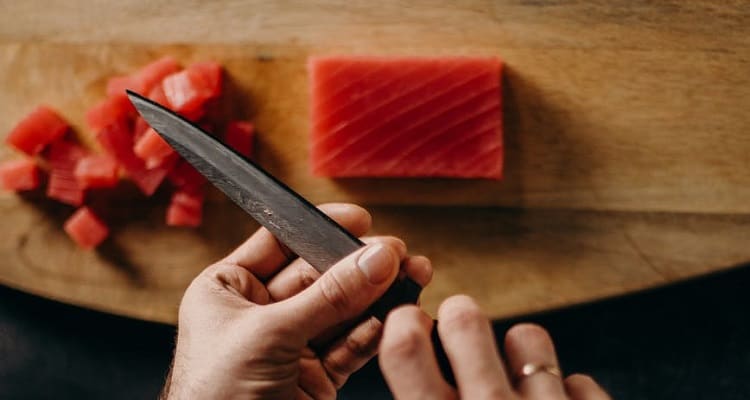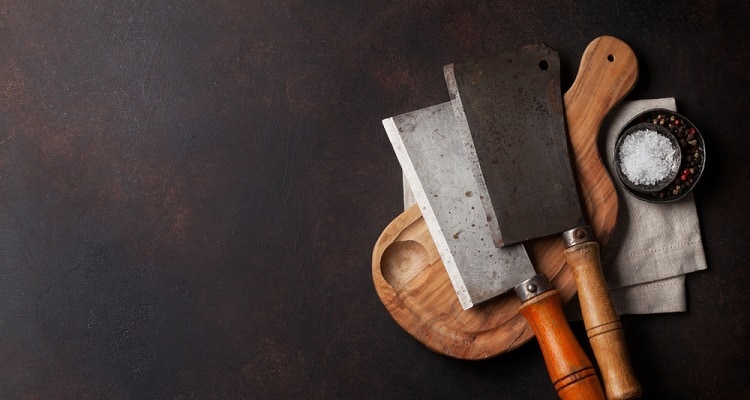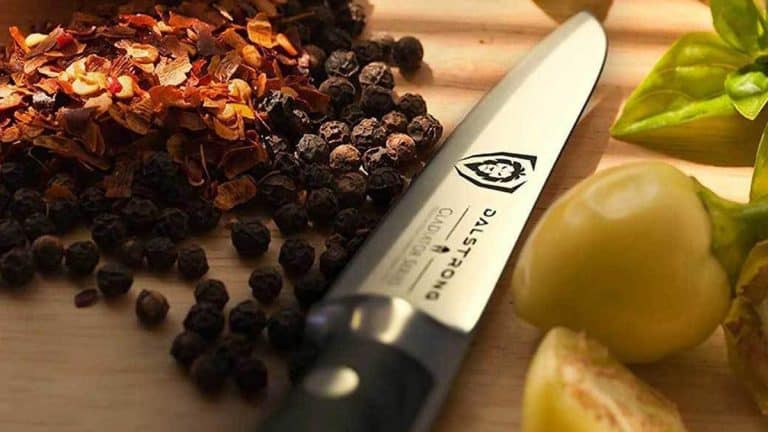
17 Popular Japanese Knives and Their Uses
Japanese knives are ideal for precision cutting. They often feature hand crafted steel that maintains sharpness while feeling balanced and light to handle. Favored by

Knife Buzz was born out of a lifelong interest in knives.
As cooking enthusiasts, we are always looking for ways to improve. One of the best ways is investing in high-quality kitchen utensils and cookware.
We review a wide range of knives used in the kitchen, the home, at work, and outdoors:
When it comes to a knife’s performance, the metal used in the blade is the most important.
Damascus Steel refers to the forging process of layering steel which results in a pattern well visible to the naked eye. Damascus blades provide greater strength and cutting power without the risk of chipping or breaking the blade.
Chef Knife Buyers Guide.
Whenever I cook meat at home, it’s automatically a special occasion. Nothing can match the tastiness of steak and potatoes or pork chops and apple sauce.
In this article, I review some of my favorite meat knives including Victorinox and Wusthof, plus up and comers such as Dalstrong and Update International. I also cover popular cleaver knives such as the Japanese Sato and Slicing vs. Carving Knives. This buyer’s guide also provides tips on how a knife’s shape affects its performance.

When picking out a proper knife for your kitchen, it’s important to understand exactly how the different physical features will alter its performance. The edge and blade shape, as well as the thickness of the knife, all contribute to a particular tool’s niche.
Knife Blade Thickness: The thicker the blade, the stronger it is. You should see a thicker blade on a carving knife than a slicing knife. However, stronger is not necessarily better.
Thin Knife Blades allow for more flexibility and more precise cuts and are generally better all-purpose knives. It’s easier to slice with thin blades, which is why slicing knives characteristically have long, narrow, blades.
Knife Cutting Edge: The knife’s edge is correlates with the thickness of the blade. In general, thinner edges, or knives with more pointed, skinny tips, are used for more precise cutting but lack the strength and control of knives with less curved, thicker edges.
Knife Blade Shape: The most distinguishing characteristic of a knife is the overall blade shape. For example, carving knives and cleavers are usually straight edged to produce the cleanest, straight cut possible when cutting through meat.
All-purpose and slicing knives have more curve to produce a more precise cut.
in the Best Beginner Knives for Cutting Meat buyers guide.
Cleaver knivess are crafted ultra-sharp and hefty to cut through meat with ease. Some cleavers are specially designed to cut through vegetables as well, making them much more versatile than you may expect.
Meat Cleavers with a Rigged Sawtooth Top Blade: If you want a cleaver for heavy-duty meat cuts, you will need a rigged sawtooth blade. This blade is designed to cut through bones.
Intended Use for the Cleaver Knife: Some cleavers can only cut through lighter cuts of meat. A lighter cleaver is a good solution when you don’t need the bulk of a heavy meat cleaver.
Cleaver Handle Grip: Sometimes, you won’t know if your knife is right for you until you hold it. The best cleaver is one that has a comfortable grip and feels balanced while chopping.
Best Vegetable and Meat Cleaver Knives Buyers Guide
When I’m cooking, I want everything done as efficiently as possible. Not only does this help me improve the quality of my dishes, but it also gives me more time with the people I love. I’ve found that one of the best ways to achieve this is by investing in quality kitchenware.
I’ve recently taken up Ceramic Knives and my prep time has been cut in half. This inspired me to write a buyer’s guide on the best Ceramic Knives on the market.
Superior Sharpness – Ceramic Blades are up to 10X sharper than metal blades. They also hold their cutting edge longer, requiring less regular maintenance or sharpening
Lightweight Feel – Ceramic Knives are often lighter than traditional metal knives. This makes them a lot easier to maneuver for beginner cooks
Precise Chopping – Ceramic Blades are often super thin, making them perfect for precise, consistent slicing and chopping
Rust-Resistant – Unlike metal knife blades, Ceramic Blades are almost always rust-resistant so they will likely last longer
Acid Resistant – Ceramic Knives are resistant to acidic foods, so they won’t absorb food odors as much as other blades
Cost-Effective Knives – Ceramic Knives have less metal content than traditional steel blades and they are often cheaper. Despite their modest price point, these knives do not sacrifice any cutting or chopping power
While there are many benefits, Ceramic Knives are more brittle than steel knives. You will need to be careful not to drop the blades on hard surfaces. Also, Ceramic Knives will eventually need sharpening. You will need to buy a specialized sharpener to keep them in action as a standard knife sharpener cannot be used.
in the Best Ceramic Knives buyers guide.
Since prehistoric times, knives have been used as tools, weapons, and eating utensils. Despite human beings using knives for over two million years, a lot of people aren’t too sharp when it comes to knife safety.
The knife injury rate in the USA is around 1.56 injuries for every 1000 residents every year, with lacerations making up 94% of all injuries. Learning the basics of knife safety can help to significantly reduce accidents and incidents. The following guide will help you to stay safe during knife use.
In the knife game quality matters. Cheaper knives tend to break and snap, which can easily cause accidents. Using the right knife for its intended purpose is also a must. And it should go without saying, never don’t drink and slice. Using a knife after drinking alcohol or taking strong medication is not a good mix.
on keeping safe in the kitchen.

Japanese knives are ideal for precision cutting. They often feature hand crafted steel that maintains sharpness while feeling balanced and light to handle. Favored by

A good knife has a sharp, serrated or straight blades that slices cleanly through cooked meat. Knife buzz has tested dozens of steak knife sets

Choosing the right kitchen knife can make prepping vegetables faster and easier. You might be wondering if the Nakiri or the vegetable cleaver fits your

A good kitchen knife makes cooking faster, safer, and more enjoyable. Whether you are slicing vegetables, dicing onions, or breaking down a chicken, a sharp